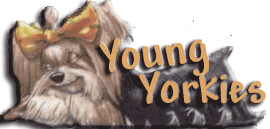| Overview:
To often the judge will become hung on
the continued reference from the standard that the coat
is of prime importance in the breed. This to the
exclusion of expectation of a sound in body and mind
animal on which is draped the characteristic blue and
tan mantle.
However, breeders and judges alike would
do this breed a favor by remembering that these are dogs
too and proportionately have the same number of bones,
muscles and teeth as any other breed. Remember that
these little canines must move and must have sufficient
room for all the internal organs that keep them alive
and keep them able to breed AND whelp naturally!
In the ring remember that the Yorkie
that runs across 20 feet will be working harder then the
GSD crossing 50 feet! Those who judge the larger breeds
or those who are thinking of judging this toy please
keep this in mind and you will appreciate the need for
FUNCTIONAL conformation in the breeds in the toy group.
All breeds in this group will fall within one of the
four body types of canine structure: low center of
gravity, terrier fronts, normal and double suspension
galloper.
Expect all in these breeds that you
would expect on any larger breed! And breeders as well
as judges, do not stress a few characteristic features
such as size, coat, expression of head, the color of
eyes or the set of the ears to the detriment of
submerging functional conformation or any part of it. Do
not judge or breed for just a dark eye, a dark blue silk
coat or a well set on ear; first breed a sound dog and
then go for the dark eye, dark blue silk coat and or the
well set on ear, depending on breed requirements as set
forth in the standard. Put functional soundness above
everything else whether the dog goes afield or spends
his life curled in someone's lap:-)).
To begin to judge the Yorkshire Terrier
one must keep in mind the original function, which was
of a toy-sized terrier, a ratter, which covers all the
small prey of similar size. Despite which opinion of the
antiquity origination of the breed you choose to believe
the one common thread is that the breed was founded on
terriers with all that word entails to judges. You will
do the breed and yourself a favor if you challenge those
exhibiting to you to present the same soundness in body
and movement along with alert personality in this toy
breed as you would want to see in any of the terrier
breeds. But keep in mind, it is a TOY-TERRIER which
means it is middle ranged toy, not as tall or large as
the Cavalier or Crested not as small as the
Chihuahua.
The challenge to the breeder of this
breed is the attempt to get it all correct in one
animal. This breed is challenging, which is why so many
take short cuts in trying to achieve what is so daunting
to so many, that being a toy-terrier, silk coat of
specificity in color and texture, sound body, sound
mouth, sound movement.
With that said, keep in mind the
standard lists no fault or disqualification.
And one of the biggest misconceptions
affecting this breed, the standard is a description of
an adult animal. If in doubt ask the age, permitted
under AKC rules; don’t expect the clear, precise
coloration of the adult in the young animal. This is the
reason so many of the breed are too light and not
holding correct coloration to their old age. A puppy is
born looking just like a Dobe or Rottie but in a smaller
package. Learn the difference in the feel of the coats
and don’t go on the color alone! A soft coated black dog
is precisely that black! A lighter colored dog holding
the correct blue coloration is to be more highly prized
then a soft coated little black that though it may fade
to a grey never contains the correct blue hue. Hint to
judges of this breed: Get yourself a wide, flat black
watch band and compare it to the adult coat in the ring;
if it matches you know they don't have the correct blue
in their coat but are a instead a black and incorrect!
The Yorkshire standard is often one of the most
misinterpreted by judges of the breed. You have to
understand the words and meaning to understand that a
clear picture is actually given on the breed. Following
the standard will be broken down in a manner that may
assist you to envision the breed you are judging.
The breed is a challenge and very
difficult to get right as if you get the coat quantity
and texture right you get the color wrong. Or you will
get the coat in perfection and the structure wrong. If
you get all that right the terrier attitude is not there
and so on.
Breeders will present to you the little
tin soldiers who they can manipulate into having level
toplines (while kneeling with them stacked) and who go
around the ring with no joy or fire in
them -
they have forgotten one of the fundamentals, this is a
terrier breed.
You will see all in the ring ranging
from purple cast to the coat (usually from the wrong use
of Black Rage) to odd off color grey-brown (usually from
the wrong use of Chocolate Kiss) to a dull black color
reflecting no light from root to end. These are the
result of short cuts and tell you that the breeder may
have gotten the structure and overall symmetry of the
breed correct but they lost out on the color. As judges
you will find that everyone will give you a different
interpretation of what a silk coat truly is, what the
correct color is in both the tans and the blues, often
times telling you at seminars that their animals are
correct and others are not. It is not without reason
many a judge gives up trying to find the correct and
thinking all the dogs are colored will only try to go
for what appeals to them regardless of correction to the
standard.
A key to keep in mind is the dog is a
terrier, albeit a toy one, so instead of saying "it's
only a toy" and rewarding bad structure, poor
temperament, lack of fire, bad mouths and so forth
justified by the mantra of "the coat is of prime
importance" a judge should have expectation of a terrier
with the sparkle, fire and working ability of one. Your
adjudication will do the breed a great service by
challenging the breeders to present this too you.
The late AKC judge, Betty Dullinger, who
had been in the breed for multiple years until her death
discussed her opinions of the Yorkshire Terrier with me
after my Cairn acquisition and knowing I had an interest
in the West Highland Whites as well. Betty shared that
in her opinion the Yorkshire's balance was very much
like that of the Westie with a relationship of ear set,
muzzle to backskull, amount of stop, size of head in
relation to the body and so forth were very
similar.
However, many had the Cairn's head and
balance instead, with the body more rectangular in
structure and relationship of balance of head to body.
And the most current rage is for neck and legs resulting
in a lack of body substance along with a narrowing of
the head and body to that of the long legged terriers.
If you fix the head and the body to head
proportions of the Westie in your mind then shrink it in
the same proportions to toy size you will see a
resemblance to many of the Yorkshire's - this should
stop you from rewarding the Afghan in miniature or the
cutesy flatter faced toy. Also, don't trust your
"instinct" or whatever you call it to judge height and
weight on this breed. You must always remember, Willis
(I believe it was) did an actual weight and height on
dogs after judges had made the decision they were too
large/tall or too heavy and 90% (yes ninety percent) of
them were WRONG!!! Again, this standard has no
disqualification; you cannot therefore weigh or measure
to get a true reading so judge on soundness and overall
balance. The odd man out of the tallest or heaviest
appearing may be more correct (and is in many instances)
then the tiny little cute one. Always remember this is a
toy TERRIER bred for ratting and although we have made
many changes to the breed since its origination ask
anyone who owns one or has lived with one, this breed is
still all TERRIER at heart. Judge accordingly.
We have had some very good
representatives of the breed who have obtained top
honors. We also have had some that have made top
rankings due to being the only ones campaigned
that
year, don't be fooled by the
advertisements of number X or number XX in standings.
Study this breed and find the common threads between
them when correct. Then reward for the same style (or
type) but challenge them for soundness Don't forget that
you can in fact judge movement in a toy as well, they
are still a canine just miniaturized.
Introduction
to Judging the Yorkshire Terrier
Seminars and lectures are a good start
as is mentoring by qualified individuals. Contact the
Yorkshire Terrier Club of America and the American
Kennel Club to arrange to be mentored in the breed by a
club member or qualified judge in your area that the
national breed club approves as qualified for this
breed. Then before you ever set foot into a ring to
adjudicate this breed attend one of the YTCA specialties
held in New York prior to the Garden each year. A
national specialty brings together many dogs from all
over the country and the New York specialty for this
breed many times attracts some of the top Yorkshire
Terriers from around the world. It affords a rare
opportunity to see dogs across a wide spectrum of breed
"style"; who in their owners’ judgment represent the
breed and their ideals in breeding. Viewed from a broad
perspective, these specialties enable us to assess our
breed’s past, present and future. Dogs in their prime
are concentrated in the Bred By Exhibitor, American
Bred, Open and Specials classes. You glimpse the past in
the Veterans classes first hand and it speaks to all
indirectly through the heritage displayed in pedigrees
in all the other classes. We must never forget this
heritage in our preoccupation with the present. Not only
do we see the past and the present but also in the
puppies, yearlings and novices here is revealed the
breeds hope for the future. They are the gauge to the
direction the Yorkshire Terriers are headed, for right
or for wrong. From them you and the breeders can assess
to what extent is being fulfilled the breed custodial
responsibility, which is to leave the breed in at least
as good of condition as you found it.
Attending a national specialty, then, is
obviously a valuable opportunity to learn about this
breed from all aspects, breeder, owner and judge! But it
can be overwhelming, especially to novices who wonder
how best to reap the benefits from this experience. In
order to help you follow the judging I have outlined a
procedure for deciding where to place the dogs in each
class. I have also included some comments about each
step. I hope they will give you a little idea what the
Yorkshire Terrier adjudication is or should be doing and
why. Use this guide and personal commentary not only to
follow what the judge is doing but also to clarify your
own ideas. I believe firmly, and urge you strongly, to
make your own decisions about the dogs. Everyone has an
opinion and a different point of view of the ideal, this
is what breeding and adjudication is about the
comparison of your breeding stock to the next person. We
all like some dogs more than others and have a
"favorite" dog at the show. But don’t be afraid to take
a stand and if the ideal you see in your minds eye after
reading the YTCA Illustrated Standard and the AKC
published standard on the breed is different then what
you see before you; then follow your ideal and choose
the best and closest to it for reward. Compare your
understanding and decision with mine but consider WHY
you prefer some to others and WHY you consider your
choice the only possible one for the coveted Best of.
PRELIMINARY CONSIDERATIONS
ABSOLUTE
RIGHT AND WRONG DOES NOT EXIST!
The Yorkshire Terrier AKC
standard defines a range, not a point, on a spectrum of
correct breed type. Reasonable people can and do
disagree about the meaning and interpretation of the
Standard. Even if they agree on the general provisions
in the Standard, they argue about how to apply the
standard to particular dogs that may not meet their
vision of the "ideal". Don’t let this confuse and
discourage you. Honest up front discussible disagreement
renders the whole experience interesting, exciting,
challenging and immensely pleasurable. Except for direct
experience with the Yorkies themselves, some of the best
Yorkshire Terrier memories should include those of
heated discussions about the meaning and interpretation
of the written word on the drop coated silk terrier that
typifies this breed. These discussions will immeasurably
enhance your understanding of true breed type. Don’t
trust your eye or your hand to measure /weigh the breed
(its probably incorrect anyway) as they have no
disqualification so judge on your opinion of the
standard. Inform your judgment, but in the end remember
it is your day to pick the dogs that fall within the
range the Standard defines.
SIMPLE ANSWERS TO
QUESTIONS ABOUT THE YORKSHIRE TERRIER DO NOT EXIST!
Some people believe a simple, straight
forward, single formula exists for judging, showing,
breeding, rearing and living with Yorkshire Terriers.
Anyone who believes this is simple minded, as
unfortunately we do not yet know many things; things
exist in the history that we can surmise but will
probably never know as well. To complicate matters
further, our supposed knowledge may greatly benefit one
dog while wreaking havoc on another to the breeds’
detriment. To most questions about Yorkshire Terriers
truth be told we can only answer an unsatisfactory "We
don’t know. It might be A, but could be B or C or even
A, B, C and X!" No one likes vague answers to questions
that we want answered desperately. But that does not
make any answer you may get wrong; just many will
purport knowledge that they do not possess rather than
to say, "I don’t know for sure".
KEEP AN OPEN MIND!
Recognize that other judges have reasonable
points of view but are human just as you. A different
point of view is not always wrong. On the one hand,
judges who place dogs in a somewhat different order
within an acceptable range are not necessarily either
stupid, blind or totally ignorant of the written
standard. On the other hand, placing the dogs in exactly
the order you would have placed them does not
automatically render these judges brilliant and
knowledgeable about the breed. Try to understand WHY
others might honestly disagree with your assessment and
then look for the merit in their decisions and opinions.
JUDGING REQUIRES
FINDING DOGS WHO APPROXIMATE AN IDEAL!
No dog
is perfect; no living creature is! Judging, therefore,
must always compromise reality and an ideal. In the end,
you must choose the best dogs in real life, not the
non-existent perfect one in your minds’ eye. The dog, in
living flesh, which comes the closest to your mind’s eye
picture of the perfect dog, deserves the prize. Remember
as a judge you must measure those in front of you
against the breed standard, a standard open to various
interpretations, rightly so!
The following
represents but one of several acceptable approaches to
judging the Yorkshire Terrier. Experienced judges may
wish immediately to alter it to suit their personal
style and procedure. New judges for the breed should
find it useful as a start that they might modify as
their experience develops. However, ALL those adjucating
the breed should follow its general ideas in order to
find the dogs that best conform to the Yorkshire Terrier
Standard.
OVERALL IMPRESSION
Gain an overall impression of the dogs as a
group at the outset. Most people may think that this
includes only an impression of the dogs as they stand in
a line. I believe it also encompasses the impression
they create in motion. Hence, I recommend that you gain
your overall impression by observing the dogs both
standing and in motion. Have them come into the ring
moving and stopping on the far side, to be hard stacked,
prior to individual adjudication, Break up the lines, if
required, to give each a fair first impression.
STANDING
At the start of every class, look up and down
the line of dogs in order to assess four critical
features:
1. Shape or Outline
Looking at the row of dogs creates your first
opportunity to determine which dogs fit the image of
the long-haired toy TERRIER the Standard calls out.
Look for the curves, depth of chest, length of neck,
body and leg that combine to produce an outline or
silhouette of a body neat, compact and well
proportioned with high head carriage giving an air of
self importance. Remember the standard first and
foremost calls out for a long-haired toy TERRIER.
Reward it highly when you see it, avoid rewarding
ribbons to those who do not possess it. If in doubt of
this meaning, I suggest observing and hands on the
terriers applying that knowledge to the meaning of
these words.
2. Presence
Don’t confuse
presence with quality! A dog with presence bears
itself as if to say, "I am THE one!". This dog does
not plead for recognition. It knows it is best and has
no doubt that you must agree. If you don’t, that is
your loss in its eye. This dog conveys an "air of self
importance" or in terrier language "stands over its
ground". Remember the Standard demands not only the
coat in its distinctive blue and tan shades BUT gives
precision in the body to be neat, compact and well
proportioned, high head carriage and confident manner.
Equally important, don’t mistake the dog with its
head held highest in the air as the one with the most
presence. In many cases the head held high may reveal
presence but it can also reveal a serious fault, the
column or steeple front. Dogs with this fault, often
seen in conjunction with ewe necks, may impress the
novice, but their strained, uncomfortable stance and
movement belies the more relaxed proud bearing of the
correctly structured Yorkshire Terrier exhibiting
presence.
3. Quality
An experienced judge said
she could not define quality; it speaks for itself.
And so it does. Dogs that possess it stand away from
the others as if they were cast in a special mold.
Look for overall quality and reward it.
4. Balance
Lack of balance greatly diminishes shape, presence
and quality. All the parts of a balanced Yorkshire
Terrier fit together. Curves and length, breadth and
depth, substance and shape hang together. A balanced
dog rests there; just as the word balance conveys and
implies. Unbalanced dogs make you feel awkward; even
the most skilled handlers cannot bend them into
balance no matter how cleverly they try. Some examples
of unbalance in a Yorkshire Terrier include: a long
backline set onto short legs; a very steep shoulder
set on with curving stifles; long legs and neck with
no forechest or depth of chest or a lack of sternum
and so forth. Caution, a dog may posses balance and
yet lack correct type! Example: a dog with a short
neck, short body, straight shoulders and straight
stifles may appear balanced but it lacks correct breed
type as set out in the
Standard. IN MOTION
After you gain an
initial impression from the dogs standing still, ask
their handlers to take them around the ring all
together. At this time do not attempt to assess sound
movement. That will come later as you individually
examine the dogs. At this point look for overall shape,
presence, quality and balance in motion. This step will
frequently surprise you. The dogs that looked best
standing still in a hard stack may not remain so in
motion. The straight dog’s shape standing can suddenly
transform into all the right soft curves required for a
smooth moving action. The balanced Yorkie standing can
in motion look as if its many parts came from different
dogs and were all just stuck together in one animal.
Many judges omit this critical step of assessing
shape, presence, quality and balance in motion. Yet,
experience will demonstrate to you that dogs standing
change substantially when in motion. This occurs not
simply because motion uncovers unsound movement but in
addition because it exposes faults in type. You will
find it difficult to choose between the dog that
possesses shape, quality, presence and balance standing
but loses them in motion and the one who possesses them
in motion but not in standing. The best Yorkies, of
course, excel in both, reward it when you find it as the
breed needs its majority to possess it as too long has
it been sacrificed to the ode of coat being prime
importance. The founders assumed all knew the coat to be
the icing on an otherwise sound dog meeting the other
requirements as set forth in the Standard.
Watch for
reach and drive! On the long legged style, you should
see an easy reach through the coat with no sign of
crossing over and no break or other sign of hackney-like
movement. As well you should be able to see the rear
kick and the bottom of the pad seen as the dog pushes
off, on no account should it appear that the dog is
single tracking or that it appears to have the rear legs
moving out of the same socket/hole. This should be at an
easy trot NOT the high speed some handling them will
move them in an effort to fool you! In the shorter
legged style you should see movement similar to that of
the shorter legged terriers and while stiffer in
movement then the long legged you should still see an
ease in movement just not as much reach or drive.
JUDGING INDIVIDUAL
DOGS
Judges differ in the extent to which
they rely on two critical elements in adjudication of
individual dogs: (1) looking at the dog and (2) feeling,
or "getting your hands on the dog". What should you be
looking and feeling for? Only by looking and then
touching can you ascertain 5 (five) basic
characteristics of the Yorkshire Terriers:
1. Substance
Proper substance means
the dog has sufficient bone, muscle, breadth and depth.
Think always of two characteristics of substance:
Put your hand around a dog’s
forearm at the elbow and run it down through the
pastern. You should feel thick bone covered with
plenty of hard muscle. The legs should have shape,
somewhat broader near the elbow than at the pastern.
They should not curve too much; particularly they
should not twist. However, forelegs should not
resemble tubes or Coke cans; that is to say they
should not appear round without any curve.
Looking
down, does the body resemble donuts stacked end to end
in an unopened box? Feel the ribcage to determine both
the breadth and the depth of chest. Think of an egg
shape or oval when feeling the chest. Avoid when
possible rewarding dogs with either a barrel chest,
slab sides or shallow sternum.
Take special care
to look over and feel the hindquarters. The croup
should neither fall steeply away nor run flat to the
base of the tail. Judges frequently overlook the
importance of the croup. Learn to identify the
properly slightly sloped croup. It contributes to the
correct tail set; it enhances the dog’s movement. The
tail set on the Yorkie is very important, a low tail
set is to be penalized more than a gay tail although
both are incorrect as the Standard calls for the
Yorkie tail to be carried slightly higher then the
backline; i.e. a one o’clock angle. Don’t forget that
under FCI rules a Yorkie tail is no longer docked;
however, there has been no statement made as to how
the natural tail should be carried. Under AKC you have
the full option of dismissing or of judging a dog with
a natural tail and will be supported either way (AKC
Judge Newsletter).
Make sure that you assess the
amount and quality of critical muscle in both thigh
and second thigh. (See below for more detail on these
points). Again many keep this breed on wire to protect
the coat and you will find many have limited muscle
tone as the owners/handlers have somewhere forgotten
that soundness requires good muscle tone.
Some
dogs have too much bone and muscle-they are what is
called coarse. Hence they, like the highly refined
"toy" dogs, lack correct type. However, coarseness is
not for the most part a breed problem. Indiscriminate
breeding leads to refinement, not coarseness, in
succeeding generations. Dogs with too much substance
occur sometimes; refinement appears too often. It is
much easier to correct coarseness than refinement in
breeding and you are judging breeding stock.
Therefore, if in doubt prefer a dog/bitch with too
much substance rather than one with far too little.
NOTE WELL: Never take this necessary preference
for coarseness over refinement to mean that the
biggest dog with the most bone and muscle should
always win! Substance must be reckoned in concert with
all other important breed characteristics! Think
always of the balance between a toy and terrier and
required strength.
2. Structure
Assessing structure
requires you to determine whether the dog is properly
put together! Dogs with the proper structure feel both
good and right; your hands should not encounter
improperly placed lumps and bumps of bone and muscle as
they move down and over a dog’s body. Instead they aught
to glide smoothly from the head over the neck through
the shoulders, over the back, to the croup and
hindquarters. Evaluating structure also requires
specifically examining with eyes and hands. Proper
structure does not give you a view of a steeple front
with the legs being a direct drop from the ears.
Head: In order to judge heads
completely, you must take into account its overall
shape and then more particularly the eyes, mouth,
teeth and jaws, ears and whiskers. We do not want
either too refined, narrow heads that resemble too
much either the Lakeland on one extreme or the broad,
thick, longer muzzled Silky OR the short muzzled
Chihuahua head with pronounced stop at the other end
of the spectrum. We should see a head similar in
balance and proportions to that of the Westie but
smaller with a flat skull on top, not too prominent or
round and the muzzle not too long. The head should
balance to the rest of the body with good flow from
the back skull to neck to shoulder with no straight
lines but in a nicely curved manner befitting a small
varmint hunter and killer. Face furnishings,
particularly whiskers, ordinarily enhance a dogs’
head; they can also conceal weak and exaggerate strong
heads serve to camouflage the weak underjaw or lack of
chiseling in the face. Furthermore, they can soften
the undesirable hard expression in some Yorkshire
Terriers. The proper adult Yorkshire Terrier head,
combined with an eager and inquisitive eye
substantially contributes to correct breed type. Don’t
overrate it, as the Yorkie is NOT a head breed, but
give it its due. Unfortunately, you will often find
unattractively plain or improper heads on dogs that
otherwise excel in type. The reverse is also true;
beautiful heads filled with type appear on dogs
lacking in other respects. As in life generally, don’t
allow the beautiful face to mar your judgment or the
unattractive on to cause you to miss an otherwise
outstanding specimen. And always check for and reward
the proper dark pigmentation, while many may try to
fool you by applying eye rims, the lips of the mouth
will always tell you real or not.
Front Assembly: Is made up of the
neck, shoulder, upper arm, foreleg, pastern and feet.
Relatively long, powerful, arched necks should set
into shoulders laid well back that slope inward at the
withers. Penalize: short necks set on too far to the
front, stuffed into loaded upright shoulders and short
upper arms; steeple fronts (also referred in some
instances as cathedral fronts) with straight shoulder
appearing to have a direct line from the bottom of the
ear. Those Yorkies with narrow, weak giraffe-like
necks set on too high; the ewe-necked toy terriers
that stand with heads uncomfortably high and necks
that break abruptly into the shoulders. Again, this is
a ratter and keep in mind one of the areas a rat would
immediately sink its teeth into in a fight, reward
accordingly.
Upper Arms: Should balance the
shoulder in length and angle; they ought also to
balance length and angle of the thigh and stifle. You
should penalize Yorkshire Terriers with straight,
short upper arms, a fault much too prevalent today.
Look for, and reward, shapely, strong forearms and
round, strong, tight feet. Look for well-filled
forechests; hollow, narrow forechests revealed in
front legs that do not allow you to easily get a hand
comfortably between them is a serious fault. Lack of
sternum is also something prevalent today with the
trend to the one dimensional creatures who look
wonderful going around but are little more then a
stick model to hold the coat.
Overall, consider
the column front, a line that runs straight down from
the base of the skull through the withers, shoulder,
upper arm, forearm to the pastern a fault of the most
serious kind in the Yorkshire Terrier as they were a
ratter and hunter of similar varmints long before they
became a toy companion.
Body: The proper Yorkshire Terrier
body contains a chest with both depth and spring of
rib. A back that is rather short over long. Sufficient
muscle throughout and a backline level over the loin.
Both sway backs, fortunately not as frequently seen,
and roached backs, unhappily more prevalent, are
incorrect. Flat toplines deserve special attention,
always assess on the move as hard stack allows for
manipulation to fool the inexperienced! Flat backlines
the same height at shoulder and rump both standing and
moving will please both the experienced and
inexperienced judge of this breed. The underline
should reveal a long brisket with good tuck up but no
wasp waists please. Look for dogs well ribbed;
ideally, the space from the last rib to the front of
the stifle should not contain more than roughly the
average sized adult humans’ three fingers.
Rear Assembly: The croup, thighs,
second thighs, hocks and feet. The proper Yorkshire
Terrier croup does not appear to slope, penalize steep
croups which detracts from the proper Yorkie type and
which indicate weakness in the power, drive and
movement of the rear. Heavy muscle should cover both
thighs and second thighs, the latter too often not
given sufficient weight. Looking at a dog from the
rear, its assembly and musculature should resemble the
working terrier like that pictured in the great
Victorian authority Stonehenge’s book. Stifles should
bend moderately; not nearly so much as the Italian
Greyhound however, nor should they be straight with a
longer hock, the latter more prevalent and a more
serious fault. Look for strength, substance and shape
throughout the rear assembly. Penalize the Yorkie with
heavy boned and muscled thighs followed by weak
spindly second thighs without the adequate muscle to
balance the thighs above.
Tail: Be sure to consider both the
structure and the carriage of tails. Yorkshire
Terriers should possess docked, thick, full-coated
tails. The thin or too long, or worse the thin and too
short tail detracts significantly from the balance and
type. As more breeds ban docking expect more with
natural tails in your ring, know the AKC "opinion" on
the subject prior to adjudication. Tails should set
neither too high nor too low. The high-set tail, often
accompanying a flat back and croup, inevitably makes
the Yorkie who possesses it carry a gay tail. Under
ordinary circumstances, they ought never to stand or
move with their tails either between their legs over
their bodies.
Coat: Three statements in the standard
cover coats in the breed. Hair is glossy, fine and
silky in texture. Quality, Texture and Quantity of the
coat are of prime importance, all 3 statements not
just one. However, when faced with the unhappy choice,
prefer too little to too much coat provided the
Texture and Quality are the better examples in the too
little coat. Recognize that this is one of the most
difficult and most important aspects to learn on the
breed. 3.
Soundness:
Typical Yorkshire Terriers possess
both sound minds and sound bodies. That is, they must
move properly and exhibit correct temperament. The
latter we too often overlook.
A Yorkie possessing sound
body moves correctly holding its topline on the go
around, no crossing or hackney-like appearance on
coming at you with a nice kick showing the pads of the
foot going away. Avoid fiddle-fronts and weak pasterns
(if you hear a click when doing a simple examination
on the rear recognize it for what it is - there is no
need for undue contortions by a judge of the rear or
front while on the table). Soundness includes having a
spring of rib along with a nice sternum easily felt.
Too many are becoming slab-sided one dimensional dogs
who look great on the go around with the elegant long
neck and long legs, which are not correct for this
breed. 4. Temperament:
Perhaps nothing detracts more from the Standard’s
requirement of commanding appearance than a timid,
frightened Yorkshire Terrier. Furthermore, shyness, as a
well-respected English breeder/judge once told me, is
one step away from viciousness. The Standard calls out
for and the breeds’ well being demands inquisitive
nature and a terrier stand over the ground fortitude.
Edgy Yorkshire Terriers are presently kept under control
by the strangle hold of their handlers (easily seen) and
without this would surely retreat or perhaps manifest
worse characteristics of a weak temperament which
includes fear biters!
PLEASE NOTE WELL: Do not
include young, misbehaved, untrained or inexperienced
dogs in this category of weak temperaments. While all
of these may distract from a dog, they do not without
more bespeak poor temperament. Most important, a
Yorkshire Terrier with poor temperament possesses
neither soundness nor correct type; it cannot possibly
show high head carriage and confident manner that
gives the appearance of vigor and self-importance with
a weak nature. 5.
Movement:
Four aspects are critical to judging
movement. They are fore, aft, reach and drive (or
stride), and overall easy and active. All are important,
but a long, easy and active stride take precedence over
the others. Forgive some faulty movement coming toward
you and going away in a dog with long low strides who
covers the ground with grace and economy. The much over
criticized cow hocks and flapping fronts are as serious
as the belabored, mincing, short strides more often
seen. Reward the animal who is striding out with the
natural easy stride showing a grab of the ground in
front and a kick to push off behind. Under no
circumstances reward the hackney stride which many
judges unfortunately interpret as being meant by the
term lively; this is after all a TERRIER and a killer of
small creatures which requires speed and agility to
accomplish the kill.
6. Fine Points:
After using the
foregoing criteria now is the time to consider the
"finishing touches" not before. The following add to
quality:
Face: EYES are medium in size and
not too prominent; dark in color and sparkling with a
sharp, intelligent expression; head is small, not too
prominent (in balance to body) or round, does not have
a pronounced stop and is not too long in muzzle (this
does not mean short); dark pigmentation (the lips,
nose and eye rims should all be black or
close.
Ears: Well set,
small and V shaped.
Feet: Round, toes tight and well
arched with black nails.
Condition: Healthy coat,
good weight and muscle tone, overall thrifty with a
strong constitution.
Coat: Dark steel blue, shaded
gold (or tan). Natural coat color is shaded in all
aspects. Standard is a description of an adult animal
and should not be literally interpreted on a dog under
the age of two years. 3 (THREE) references to coat
descriptors all of equal importance: quality, texture
and finally quantity). If taken in order then quality
and texture are more highly prized and desired then
quantity. THE FINAL JUDGMENT
After you
have examined each dog individually, divide your final
judgment into two phases. During the first, tentatively
arrange the dogs in the order you prefer them, according
to decisions made in your overall impressions and
assessments of individual dogs. Keep in mind that the
overall impression while important is not everything.
The beautiful silhouette is sometimes weak, overly
refined, in poor condition and can suffer from important
structural problems. These latter will always discount
to superior shape and soundness.
Secondly, ask the dogs to go around the
ring together one (or at most two) last times(s). This
is no mere formality; neither is it a staged action to
increase suspense and test the exhibitor’s endurance.
You will often rearrange dogs on this final go around.
Why? Not for movement as such. Instead, in this last go
around you will often find the dog who excels in shape,
quality, presence and balance both standing and in
motion. Hopefully, the dog you put tentatively at the
front of the line will retain the best shape, display
the same quality, posses the same presence and
demonstrate equal balance in motion that it did standing
still. If not, then do not hesitate to replace it in
your placement. In the end, the winning dog should best
fit the description:
That of a
long-haired Toy Terrier whose blue and tan coat is
parted on the face and from the base of the skull to
the end of the tail and hangs evenly and quite
straight down each side of the body. The body is
neat, compact and well proportioned. The dog's
head carriage and confident manner should give the
appearance of vigor and self importance.
Understanding the foregoing, let's
proceed to the actual examination.
EXAMINATION NOTES FOR
JUDGES
*A Yorkshire should show interest and
sparkle, as with the terriers, this should not be a shy
dog.
* Most exhibitors will walk in, drop to
their knees and hard stack the breed. Recognize that
this does not allow the animals in the ring to build up
in excitement but causes them to do the proverbial
up/down that wears them down quickly and does not allow
for the response when the reward is on the line. I
strongly encourage judges to ask the exhibitors to stand
and allow the dogs to stand natural; this will give you
a much clearer idea of what the dog in front of you is
really about.
* Do not reward one who attempts to bite
a human but do not punish an attempt to spar with
another dog. Think terrier attitude.
* This breed is shown on a table and
does require a hands on examination to "see" beneath the
coat, do not be afraid of putting your hands on the dogs
(and into the topknot if questionable) but gentleness in
touch will allow a more natural stance then using the
heavy hand that many do. The dogs learn early on to move
out of the way of feet and while fearless with other
animals are aware with human touch of their miniature
size
* First look at the dog on the table to
see if it is presenting an alert interest in what is
going on in the ring and around them. Does the action of
the dog show it is "standing over it's ground" on
the table? Head should be up with a keen eye looking at
you with interest. Walk up to them confidently, not too
slowly, and go over them impersonally. While gentle is
appreciated don't be afraid to touch.
* On the table recognize the breed
overall is taught to be hard stacked, give a bit of time
to allow this but do not encourage the regrooming of the
dog on the table. Many exhibitors, knowing judges
are taught coat of prime importance, spend extraordinary
amounts of time grooming the coat rather then checking
the stance of the dog.
* Many of the breeds object to having
their vision blocked during the exam of the mouth,
Yorkshire's are no different; these dogs can have their
lips raised from beneath the chin and since there is no
disqualification or fault for teeth and mouth, a short
exam is all that is needed. However, again remember a
sound dog and the teeth should be clean and should be
enough to allow to assess the real bite of the
dog.
* Hands-on is necessary to evaluate
structure and muscle tone. Lift or part the coat to see
the feet as many of the breed will show broken pasterns
and flat feet from the time spent on wire
to
protect the coat. Recognize that this will cause some of
the topline faults you may see. Remember the standard
states sound animal!
* Do not go overboard on the noises,
while you may get a response the first time this
intelligent breed quickly gets your number. A better
trick is to see how they respond to a furry toy tossed a
bit away from them, but only use this for a final
decision if needed.
* Most will respond to bait if used
correctly, unfortunately many feed the dogs rather then
bait/tease the dog. As a judge you control the ring and
can put a stop to this and to the running up on other
exhibitors, crowding the line up and so forth.
*If you judge terriers don't be afraid
to spar these toy ones.
* You will find a common theme on
examining Yorkshire is that they refuse to put all 4
feet on the table at the same time, it is very typical
for them to lift one of their front legs. Expect it
and
go on.
* Do not be surprised by wild excitement
at the examination, this breed is not reserved for the
most part. Expect a Yorkshire to like you, they do, they
really do!
* Be aware of the faults profuse coat
can hide, you need experienced eyes that can "see"
through the coat some of the faults are flat feet, long
or big ears, shallow chest, lack of sternum, rears that
look like both legs come from the same hole. Or the
illusions of faults it can create elbowing out, flipping
pasterns, bad rear, ewe neck and so forth. While some
watch the coat, with "experienced" eyes you will see the
actual movement and should see the pads push in the rear
and the front reach out towards you through the
coat.
* Exhibitors should be encouraged to
show on a loose lead in order to assess natural head
carriage and movement. However, many of the breed will
stride out in confidence ahead of the
handler,
be aware that a tight lead may be due to the dog itself
rather then "stringing" up to cover a fault. Know the
difference in the look. Exhibitors should be encouraged
to move at a natural and easy stride for the breed.
There are many top handlers and knowledgeable exhibitors
that seem to think the ring is for speed or a foot race.
Don't be fooled, make them slow down to a jaunty walk
for the dogs.
* The gait of this toy terrier is best
assessed at a medium speed; however, few exhibitors will
believe you really mean it when you ask them to go
slowly. Just as they will be shocked when you ask them
to stand naturally allowing you to assess the natural
dog.
On to discussion of the AKC standard.
You will find that I moved some of the General
Appearance terms to the box of what is being
described:
.
|
GENERAL
APPEARANCE |
| . |
Yorkshire Terrier
AKC
Standard.
That of
a long-haired toy TERRIER whose blue and tan coat
is parted on the face and from the base of the
skull to the end of tail and hangs evenly and
quite straight down each side of the body. The
body is neat, compact and well proportioned.
The dog’s high head carriage and
confidential manner should give the appearance of
vigor and self – importance.
.
Weight- Must not exceed 7
pounds. |
| . |
Carolyn Hensley
Judging Interpretation of the
Standard.
This
statement conveys a lot to a judge. You should
expect terrier characteristics in the body of a
toy. The head should be carried high,
confident, vigorous and self important. All
these fit the terrier breeds whose many standards
talk to similar by stating stand over their ground
and so forth. This breed should convey all
of that too you. A great test is to ask the
exhibitor to save their prayers for religious
services and for them to stand up letting the dogs
stand naturally.
.
The body is neat – look
up this word in the dictionary, the old English
term is n at and means: Orderly and precise in
procedure; systematic.
.
Compact
again going to the old English term means:
closely and firmly united or packed
together; heavy and compact in form or stature; "a
wrestler of compact build"; "he was tall and
heavyset"; "stocky legs"; "a thick middle-aged
man"; "a thickset young man" [syn: heavyset,
stocky, thick, thickset] .
.
Well
proportioned, not one area should stand out from
the other it means: Agreeable or harmonious
relation of parts within a whole; balance or
symmetry.
.
Coloration should be
blue and tan, this does not mean grey and blonde
or white and gold and most assuredly not purple
like cast to the body.
.
Must not
exceed 7 pounds. Since this is not a fault
or disqualification you cannot scale the
dogs, therefore concentrate on proportions
and symmetry.
.. | .
|
SIZE,
PROPORTION, SUBSTANCE |
| . |
Yorkshire
Terrier AKC Standard.
The body is neat, compact and well
proportioned. Well proportioned and very
compact. The back is rather short |
| . |
Carolyn
Hensley Judging Interpretation of the Standard
. This is as key in judging this breed
as with the coat is you need to recognized
that this same language is repeated in the
General Appearance portion of the standard
as well as in the description of the size,
proportion, substance.
.
Again is stated:
The body is neat – look up this word in the
dictionary, the old English term is n at and
means: Orderly and precise in procedure;
systematic.
.
Compact again going to
the old English term means: closely and
firmly united or packed together; heavy and
compact in form or stature; "a wrestler of
compact build"; "he was tall and heavyset";
"stocky legs"; "a thick middle-aged man"; "a
thickset young man" [syn: heavyset, stocky, thick,
thickset] .
.
Well proportioned, not
one area should stand out from the other it
means: Agreeable or harmonious relation of parts
within a whole; balance or symmetry.
.
However, here introduced for the first
time is that the back should be rather short. Does
this mean short-backed, no, although it
is interpreted that way by many. The
precedence is on proportion, neat and so
forth as descriptors. However, preference should
be that the back is RATHER short over the
longer backed animals.
.
These
statements take an understanding of canine
structure to put into the proper framework.
.
B had the correct length of
back.
A is too long and C is too short.
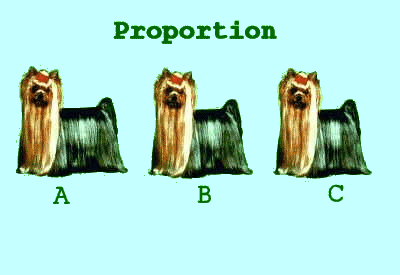 .
B is the best proportioned. .
B is the best proportioned.
A is too short in leg, C is too long in leg.
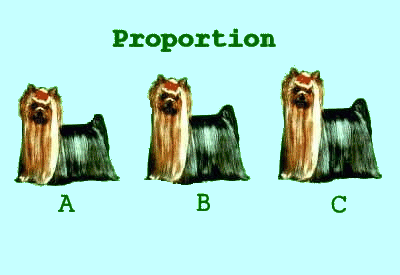 . . |
|
HEAD |
| . |
Yorkshire
Terrier AKC Standard.
Small and rather flat on top, the skull not to
prominent or round, the muzzle not to long,
with the bite neither undershot nor overshot and
teeth sound. Either scissors bite or level bite is
acceptable. The nose is black. Eyes are medium in
size and not too prominent; dark in color and
sparkling with a sharp, intelligent expression.
Eye rims are dark. Ears are small, V-shaped,
carried erect and set not to far
apart. |
| . |
Carolyn Hensley
Judging Interpretation of the
Standard.
 . .
Again, relative proportion comes into
play here. The head small, which is a
relative term, it would be clearer to judges if
the term “in proportion to the body” were to
be introduced into the language.
.
The skull not to prominent or round.
This would tell you that the dog needs a
moderate stop or the skull can become
prominent or round appearing. And why
the encouragement of the helmet like poufs on the
head? Encourage a more natural look when judging
the breed and perhaps some brave soul will do the
twin top knots ala the Maltese and show off a good
Yorkshire head.
.
The muzzle not
too long. Again in proportion. It also does
not state the muzzle should be short just
not too long, major difference.
.
Teeth sound. My goodness the dogs that
finish in this breed with missing, misshapen,
dirty and so forth teeth is amazing and goes
totally against the word sound. It goes on
to state the bite is neither undershot nor
overshot with no preference to scissors or level
bites.
.
Nose black. Eye rims
are dark. If you stop to consider this it is
to
encourage the pigmentation a
requirement if this breed is going to hold
correct color.
.
Eyes are medium in
size and not too prominent. This contradicts
the tendency to what is commonly called a
baby-doll face as in that look with the
short muzzle the eye is large and round. Dark in
color does not say black does not say hazel or any
other shade other then dark. However, again the
attitude of sparkling with a sharp intelligence; I
want to remind you this is a toy terrier think of
that expression in the bulk of the terrier breeds.
.
Ears small, v shaped, carried
erect and not too far apart. This does not
mean they are to touch on top of the head, they
should be set apart or why would the standard
state not too far apart? Small, in
proportion again as it does not give you a
reference to the word small. V shaped gives you a
good visual of a prick ear coming to a point
on the end.
B is the correct head
carriage. A is too short
and C is too long of
a neck.
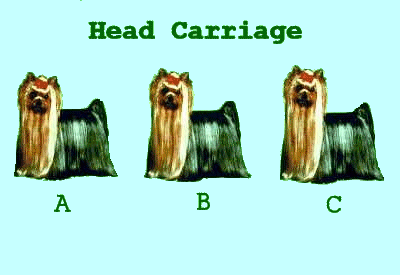 ..
B is the correct muzzle. ..
B is the correct muzzle.
A is too downfaced, C is too short.
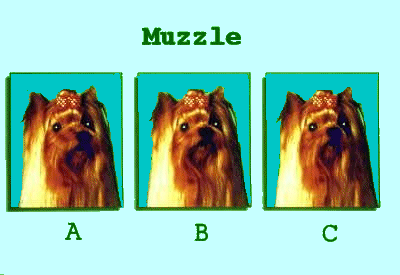
B is the correct ear set.
A's ears are too wide, C's ears appear to be
tied up.
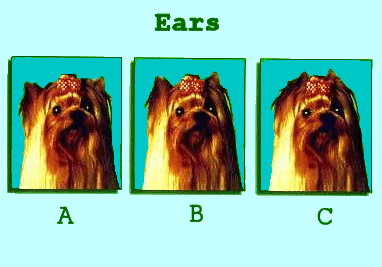
| .
|
NECK, TOPLINE
AND BODY |
| . |
Yorkshire
Terrier AKC Standard.
Well proportioned and very compact. The back
is rather short, the back line level, with height
at shoulder the same as at the rump. The
dog’s high head carriage and confidential
manner should give the appearance of vigor
and self – importance. TAIL-docked to a
medium length and carried slightly higher
than the level of the back. |
| . |
Carolyn Hensley
Judging Interpretation of the
Standard.
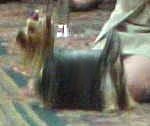 . .
Once more is repeated: The body is neat
– look up this word in the dictionary.
Compact again going to the old English term
means: closely and firmly united or packed
together; heavy and compact in form or stature; "a
wrestler of compact build"; "he was tall and
heavyset"; "stocky legs"; "a thick middle-aged
man"; "a thickset young man" [syn: heavyset,
stocky, thick, thickset] .
.
Well
proportioned, not one area should stand out from
the other it means: Agreeable or harmonious
relation of parts within a whole; balance or
symmetry.
.
However, here again is
introduced is that the back should be
rather short. Does this mean short-backed, no,
although it is interpreted that way by many.
The precedence is on proportion, neat and so forth
as descriptors. However, preference should be that
the back is RATHER short over the longer backed
animals.
.
The backline
level. Note it does not say the back, nor does
it say the spine, it states the backline with the
height at the shoulder the same as at the
rump. Unfortunately, this is many times achieved
in the ring by a straight shoulder and tilted
pelvis. Do not judge the toplines with the
exhibitor on the floor holding the dog
straight and pushed together, let the dog stand
natural and look at the topline on the go around!
.
C has the correct topline.
A is roached back, B is down in the shoulders.
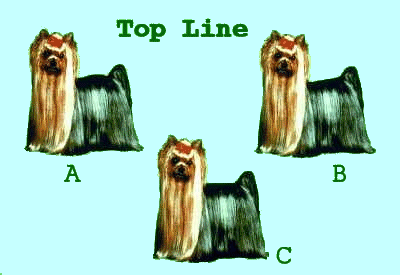 | .
Tail is docked under AKC rules.
However docked or undocked the carriage is
more important. Note it states carried
slightly higher the back, this does not mean
high up on the pelvis creating a gay tail.
.
*AKC Judges Newsletter: Fall 2002
In
accordance with Chapter 7, Section 15 of the Rules
Applying to Dog Shows, A judge's decision shall be
final in all cases affecting the merits of
the dogs. Full discretionary power is given to the
judge to withhold any or all prizes for want
of merit.
.
It is the judge's
interpretation of the breed standard on the
day. In each of these situations you may
judge the exhibit and place the dog you feel
appropriate based on its quality in
comparison to the other dogs being
exhibited. Or, you may excuse the dog from
the ring noting that the exhibit is not consistent
with the breed standard, natural tail, natural
ears, etc.
.
B has the correct tail
carriage.
A is too far forward, C is
down.
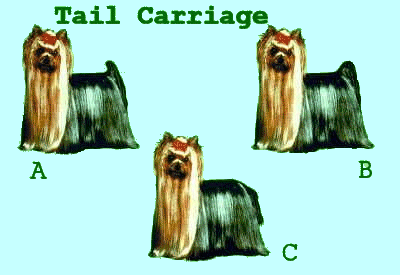
C is carried at a 45 degree
angle which is the correct tail set.
A is too
low, B is too gay (high)
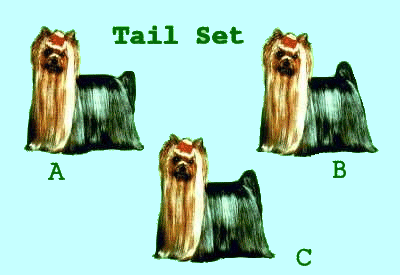 .
A has the correct tail
length. .
A has the correct tail
length.
B is too short, C is too long.
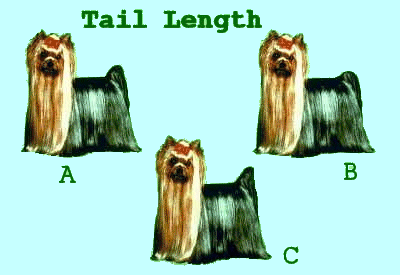 . . |
|
FOREQUARTERS,
HINDQUARTERS, LEGS AND FEET |
| . |
Yorkshire
Terrier AKC Standard.
Forelegs-should be straight, elbows neither in
nor out. Hindlegs-straight when viewed from
behind, but stifles are moderately bent when
viewed from the sides. Feet-are round with
black toenails. Dewclaws, if any, are generally
removed from the hind legs. Dewclaws on the
forelegs may be removed. |
| . |
Carolyn Hensley
Judging Interpretation of the
Standard.
B has the correct front
assembly.
A is too wide, C is too narrow.
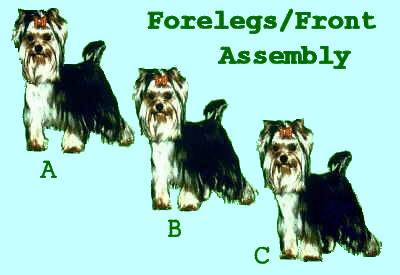
. This section is very self
explanatory but I have introduced it again in my
interpretation of
Gait. | .
|
GAIT |
| . |
Carolyn Hensley
Judging Interpretation of the
Standard.
  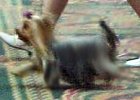 . .
There
is nothing in the standard to describe a
Yorkshire’s gait. But go back to general
appearance, go to the description of the
body and this tells you the type of gait one
should expect.
.
Here is my
interpretation of what it should be, taking my
cue from my terrier knowledge and exposure.
.
Should be free, light-footed, lively and
straightforward. Hindquarters should have
strong propelling power. Toeing in or out is to be
faulted. As seen from the front and from the rear,
the legs are straight from the shoulder and hip
joints to the pads, and move in parallel to the
centerline of travel. The rear legs move in
the same planes as the front legs. As the dog
moves at a faster trot, the front and rear legs
and feet
may tend to converge toward the
centerline of travel, but the legs remain straight
even as they flex or extend. Viewed from the
side, the legs move in a ground covering stride.
The rear feet should meet the ground in the
same prints as left by the front feet, with
no gap between them Topline remains firm and
level, without bounce.
. | .
|
COAT |
| . |
Yorkshire
Terrier AKC Standard.
Quality, texture and quantity of coat are of
prime importance. Hair is glossy, fine and silky
in texture. Coat on the body is moderately
long and perfectly straight (not wavy). It may
be trimmed to floor length to give ease of
movement and a neater appearance, if
desired. The fall on the head is long, tied with
one bow in center of head or parted in the
middle and tied with two bows. Hair on
muzzle is very long. Hair on muzzle is very
long. Hair should be trimmed short on tips of ears
and may be trimmed on feet to give them a
neat appearance. |
| . |
Carolyn Hensley
Judging Interpretation of the
Standard.
Now
begins the portion that confuses many.
No where does it say the coat is of prime
importance, it describes 3 (three) features
of the coat that are of prime importance.
.
Quality-
just what is meant by this word? Again I would go
to the dictionary and find what the word really
means. To me it says that the whole overall
condition of the coat and color is of
importance.
.
Texture – this again
emphasizes that the correct silk is of more
importance then the color which supports that to
reward a soft coated dog, even if the clerical
grey in color over a lighter dog with the correct
blue hue which says the correct structure is
there, is very wrong and should be discouraged in
judging.
.
Quantity – this says
that the coat should have sufficient
quantity with which to judge the texture and
quality.
.
The further descriptions are
again very self explanatory. However, when
thinking of silk I would advise you to go to a
high end store and place your hand fore and aft
against and feel the true heavy silk, feel the
coolness and let that sink into your memory so
that when your hands are going over the
Yorkshire that memory is there.
.
Also,
please note that no where does it state the bow
must be red, although traditional many colors are
more flattering to different shaded heads
then the traditional red. This should make no
difference to a judge as you are not there to
interpret bow size or color!
. | .
|
COLOR |
| . |
Yorkshire
Terrier AKC Standard.
Puppies are born black and tan and are
normally darker in body color, showing an
intermingling of black hair in the tan until
they are matured. Color of hair on body and
richness of tan on head and legs are of
prime importance in adult dogs, to which the
following color REQUIREMENTS apply: Blue-Is
a DARK steel blue, not a silver-blue and not
mingled with fawn, bronzy or black hairs.
Tan- All tan hair is darker at the roots than in
the middle, shading to still lighter tan at the
tips. There should be no sooty or black hair
intermingled with any of the tan. Color on
the body- The blue extends over the body
from
the back of neck to root of tail.
Hair on tail is darker blue, especially at
end of tail. Headfall- A rich golden tan, deeper
in color at sides of head, at ear roots and
on the muzzle with ears a deep rich tan. Tan
color should not extend down on back of
neck. Chest and legs-A bright rich tan, not
extending above the elbow on the forelegs
nor above the stifle on the hind legs.
. |
| . |
Carolyn Hensley
Judging Interpretation of the
Standard.
I
don’t know how anything could be more descriptive
then this section of the standard. It again
addresses that the coloration of the puppy is NOT
that of the adult dog that is fully matured.
.
Note the color referenced is tan, darker at
the roots, Dark steel blue and so forth.
.
Now how to judge the breed on color when so
many are colored in the ring both on
headfall and body? Learn correct texture and
quality of a good coat and reward it. When judging
part the coat at the front and rear leg, if it is
colored most do not take the time and effort
to check underneath. Learn the correct placement
of the saddle and check where the tan ends
and the blue starts, is a smudged line or a clear
demarcation? The shading is always darker at
the roots in the blue and the gold getting
darker the further the shaft is away from the
body, same color all the way and on a fully
mature adult, question
enhancements.
.
B is the correct color.
A
is too light, C is black.
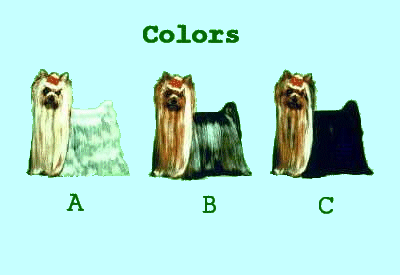
| |
